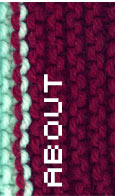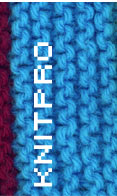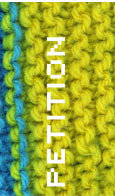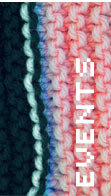 |
Interview
with Roian Atwood
Director of Community Relations and Organic Programs,
American Apparel
Los Angeles, California
July 28, 2004
mR: microRevolt
RA: Roian Atwood
|
|
mR: Can you say your name
and what you do at American Apparel?
RA: My name is Roian Atwood
and I am the Director of Community Relations and Organic Programs,
starting off in more of a community relations capacity. American
Apparel (AA) has this philosophy that we are only as strong
as the local community that supports us. This building that
we’re in here, on the corner of 7th and Alameda was
built in 1929, it’s a very old building, it was vacant
for many years before we moved in here. We moved in here with
a conscious intention to sort of re-vitalize the downtown
Los Angeles industrial community but also the communities
of Boil Heights and East LA, Echo Park, some of these surrounding
neighborhoods, heavily immigrant and ethnic neighborhoods
that could use that sort of economic vitality and stimulation.
So, originally working in the community working with different
organizations and groups but also looking out on a much broader
level too because AA enjoys participating on an intellectual
level with academic institutions and academic communities,
but also through conferences and workshops and various different
capacities talking about our business model, talking about
what we’re doing and how we’re doing it differently,
and why it’s important as an American story but also
a business story in general.
Probably the story that we’re most well
for is the socially responsible story, and I can talk a little
bit about that. But we’ve gotten a little bit away from
talking about just the socially conscious story for very good
reason.
mR: But before we talk about
how you got away from that, can you just say a little bit
more about what sets you apart and what your social responsibility
claims are. What sets you apart from other companies in the
garment industry?
RA: Right. We like to think
of ourselves as sort of the huge success story because we
have from our understanding the highest paid wages in this
industry for these kinds of jobs. After Levis-Strauss closed
down the last remaining North American plants last October,
the US Dept of Labor estimated that 96% of all clothing was
manufactured overseas and imported in the US. That means that
AA is of the remaining 4% domestic apparel production, which
is interesting too because of that 4% is going to be high
end fashion. It’s a little bit easier to do domestically
than it is something as simple as basic blank universal tees.
mR: Can you say more about the sweatshop
issue because I know that a large amount of your consumers
are excited about that and buy AA because of the anti-sweatshop
claim.
RA: I think a lot of people
possibly like it as an after thought. People ask us, how much
feedback does AA get: “I’m buying your product
because its’ sweatshop free”. It’s a little
difficult to gauge sometimes because we don’t always
see the end user, we’re seeing the end user a little
more in the retail environment obviously, but sense we’re
selling through wholesalers and silk screeners and they’re
using our product and being the end user, but I did ask Pat
Honda who is our Customer Service representative and she once
told me she would estimate about 10% of our customers gave
us that feedback, that they appreciate what we’re trying
to do. I mean I get it all the time, on the phone, talk to
people, emails, I mean we get testimonials, “we love
your company, we love what you’re trying to do”
but you know even if we get 100 emails in a month we have
a database of 50,000 customers. We work with 50,000 people
so 100 emails in a sea of 50,000 people doesn’t equate
to a whole lot. We like to label our market as “trend
conscious young adults”. Trend conscious because they
might be concerned about the sweatshop issue but they also
might be looking for more fashionable clothing, and they like
hot clothing and isn’t it nice that it’s sweatshop
free. Or, it’s sweatshop free and I’m buying with
my ethics, isn’t it nice that it’s a little stylistic,
so it kind of falls on this large group of parameters. But,
when we initially started, we were not using the term “sweatshop
free” we were using the term “passion, innovation,
style and ethics,” that was like our subtitle. And then
at one point we switched to “sweatshop free” and
we actually had that trademarked for a while.
mR: For a while? It isn’t
any longer?
RA: It’s no longer
trademarked.
mR: Why?
RA: We were definitely going
for the social message for a long time, for a good year, a
year and a half solid.
mR: 1999?
RA: A little bit later I
would say 2001, maybe 2002. When we first started American
Apparel wasn’t paying the wages we are now. When AA
first started we were operating in Mexico but there’s
this evolution that occurred. You know, Dov was actively reading
Adbusters magazine, having conversations with people about
the sweatshop issue, and when he went to Mexico and visited
the homes of workers that were employed by the contractor
for the facility that Dov was working with, he was appalled.
I mean just very simply it doesn’t take much to say,
this is appalling. I mean I think if you go bare witness to
the actual events that are happening, any person, within reason,
you know I’m sure there is some different groups, would
say no, this doesn’t make sense, somehow this doesn’t
make sense. So he was working with a contractor that would
hopefully make changes, the contractor would say “Oh
yes, yes, yes”, Dov would go and come back – it
wasn’t working out, so that’s when Dov realized
the only way to he could truly create what we called “sweatshop
free” was by overseeing it first thing, bringing it
to Los Angeles and beating out the rest of the competition
with higher efficiency times. Although I’m not sure
if he even knew that then, that high efficiency times was
going to be one of the best ways that we could compete with
off shore competitors.
So he brought it here to start AA, people
were making just minimum wage to start. As the company grew,
as we were a little more profitable, as we sort of became
more solid we had a bigger client base that wage was constantly
increasing. The benefits that we then offered just were slowly
growing and growing and growing, so the company that was offering
no benefits, it was paying minimum wage, became the highest
paid sewing operators and has one of the best benefit packages
in the apparel industry today. Paid time off, full health
care benefit, we pay about 70% of the cost of health insurance,
dental, lunch, we can go strait through it talking about benefits.
We got a little bit away from "sweatshop
free (TM)" because we didn’t want to limit ourselves
to just a niche market. And when you talk to Manou you might
actually ask him that question about SweatX, “Do you
feel that SweatX was tailoring just to a niche market?”
With a label title of “American Apparel” or a
company name “American Apparel”, it’s pretty
generic, you don’t get more generic than “American
Apparel”, which is good and you know it’s not
the most exciting name either. But what it does is it really
allows for a large variety of people. When you label yourself
as “SweatX” you might question that. It seems
like immediately, at least in human dynamics, polarization
happens very easily when you offend someone or you challenge
someone’s views, vantage points or belief structure.
“SweatX” and then it’s like, well I’m
not buying from you, what are you saying about all my other
clothes?” You know what I mean? There’s something
about the psychology maybe of positioning yourself a little
too strongly. But American Apparel, well, “made in downtown
LA, sweatshop free” was our byline; it was the second
line of American Apparel. Was it the forefront of our message?
Yah, it was the forefront of our message a lot, but I think
what we decided was that in order to grow and move forward
to the next level, it was something more, it‘s something
more than just about being sweatshop free, offering benefits,
offering high wages. You know what forget about it. That should
be standard. We’re not doing anything exceptional here,
no, this should be an industry standard. Sweatshop free should
be in every apparel company across the world, that’s
basic. What we need to talk about now, our next step is business
efficiency, and how can businesses operate in the most efficient
way, not only for profitability’s prospective, but for
environment, for the benefit of humanity. And maybe, maybe
manufacturing goods way over here, transporting them way over
here is just an inefficient model.
|







